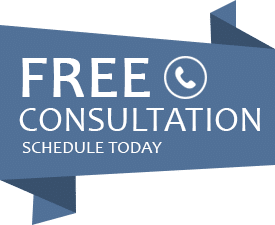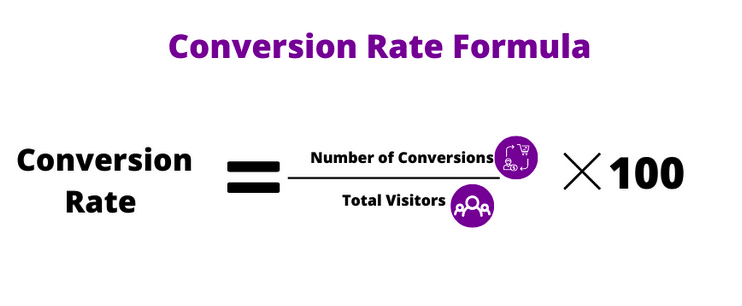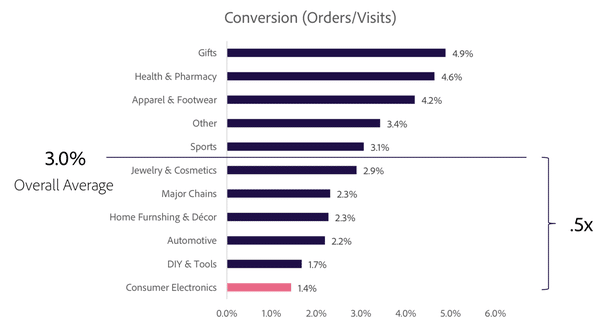 In the dynamic world of e-commerce, understanding and optimizing conversion rates is a fundamental aspect of success for retail companies. Conversion rates measure the percentage of website visitors who take desired actions, such as making a purchase, signing up for a newsletter, or completing a form. Learn the importance of conversion rates for retail brands operating e-commerce websites. Looking to improve online sales? Knowing where you are is a good start. Retail website conversion rates can be improved. Work with retail business experts to get better results through consulting services, or retail marketing services.
In the dynamic world of e-commerce, understanding and optimizing conversion rates is a fundamental aspect of success for retail companies. Conversion rates measure the percentage of website visitors who take desired actions, such as making a purchase, signing up for a newsletter, or completing a form. Learn the importance of conversion rates for retail brands operating e-commerce websites. Looking to improve online sales? Knowing where you are is a good start. Retail website conversion rates can be improved. Work with retail business experts to get better results through consulting services, or retail marketing services.
Understanding Conversion Rates: Industry Data and Benchmarks
According to data from Statista, the average conversion rate for e-commerce websites across industries is around 2.86%. However, conversion rates can vary significantly based on factors such as industry, product type, target audience, and website design. For example, the apparel and accessories industry typically sees higher conversion rates, averaging around 3.41%, while industries like home and garden may have lower average conversion rates at around 2.32%.
It’s essential for retail companies to benchmark their conversion rates against industry averages and track performance over time to identify areas for improvement and optimization. Industry-specific data provides valuable insights into what constitutes a competitive conversion rate within a particular sector and allows companies to set realistic goals for conversion rate optimization (CRO) strategies.
The Benefits of Improving Conversion Rates
Increased Revenue: A higher conversion rate directly translates to increased sales and revenue for retail brands. By optimizing the conversion funnel and improving the user experience, companies can capture more of their website traffic as paying customers, maximizing the return on investment (ROI) from marketing efforts.
Improved Customer Experience: A streamlined and user-friendly website experience enhances customer satisfaction and reduces friction in the purchasing process. Implementing CRO strategies such as clear calls-to-action, intuitive navigation, simplified checkout processes, and responsive design ensures a positive user experience, leading to higher conversion rates and repeat business.
Enhanced Marketing Efficiency: Improving conversion rates allows retail companies to achieve better results with their marketing campaigns. Whether it’s pay-per-click (PPC) advertising, search engine optimization (SEO), email marketing, or social media promotions, higher conversion rates mean more efficient use of marketing budgets and increased ROI on advertising spend.
Competitive Advantage: Retail brands with optimized conversion rates gain a competitive edge in the market. A website that converts visitors into customers effectively outperforms competitors with lower conversion rates, attracting more sales, customer loyalty, and market share.
Data-Driven Decision Making: CRO strategies rely on data analytics and insights to make informed decisions. By analyzing user behavior, conversion funnels, traffic sources, and conversion paths, retail companies can identify bottlenecks, test hypotheses, and implement data-driven optimizations that drive measurable results.
 Key Strategies for Improving Conversion Rates
Key Strategies for Improving Conversion Rates
Optimize Website Design: Ensure a visually appealing, responsive, and user-friendly website design that aligns with brand identity and facilitates seamless navigation and product discovery.
Clear Calls-to-Action (CTAs): Use compelling and strategically placed CTAs to guide visitors towards desired actions, such as making a purchase, signing up for a newsletter, or requesting more information.
Simplify Checkout Process: Streamline the checkout process by minimizing form fields, offering guest checkout options, providing multiple payment methods, and ensuring secure transactions to reduce cart abandonment rates.
Implement A/B Testing: Test different variations of website elements, such as headlines, images, CTAs, and page layouts, to identify which designs and messaging resonate best with your audience and drive higher conversions.
Personalization: Leverage customer data and behavioral insights to personalize website content, product recommendations, and promotional offers tailored to individual preferences and purchase history.
Optimize Page Load Speed: Improve website performance by optimizing page load speed, reducing bounce rates, and providing a smooth browsing experience across devices.
Maximizing Success Through Conversion Rate Optimization
Understanding and optimizing conversion rates is a critical factor for retail companies operating e-commerce websites. By benchmarking against industry averages, implementing data-driven CRO strategies, and continuously improving the user experience, retail brands can increase revenue, enhance customer satisfaction, improve marketing efficiency, gain a competitive advantage, and make informed decisions based on actionable insights.
Improving conversion rates requires a holistic approach that encompasses website design, user experience optimization, marketing strategies, and data analytics. Retail companies that prioritize conversion rate optimization as part of their digital strategy are better positioned to succeed in the competitive e-commerce landscape, drive sustainable growth, and achieve long-term business success. Looking to improve online sales? Knowing where you are is a good start. Retail website conversion rates can be improved. Work with retail business experts to get better results through consulting services, or retail marketing services.









